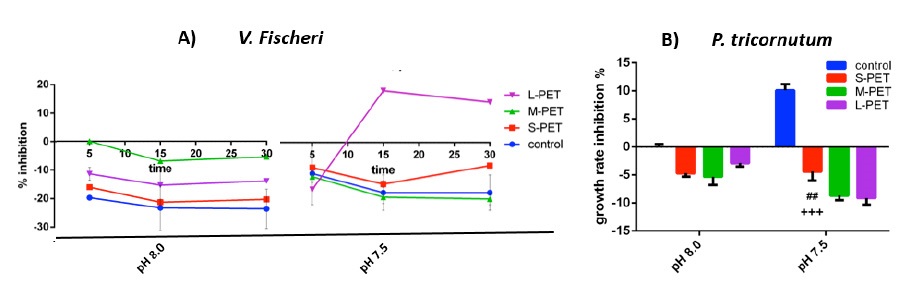PhD Top Stories
Manuela Piccardo
PET microplastics toxicity on marine key species is influenced by pH, particle size and food variations
Doctoral Programme in Environmental life sciences (in collaboration with Universitŕ degli Studi di Udine)
Microplastic pollution is recognized as one of the most serious threat to the health of marine ecosystems and potentially to humankind. Microplastics (MPs) are all plastic particles < 5 mm in diameter and can be divided, by origin, in primary (intentionally produced in such dimension, e.g. as abrasive in cosmetics and industrial products), or secondary MPs (obtained by fragmentation of larger plastic items). The Mediterranean basin can be considered a hot spot of plastic pollution with an accumulation of floating plastic between 1,000 and 3,000 tons. MPs exposes animals not only to the physical particles, but also to a “cocktail” of chemicals intentionally associated to the plastics in order to improve performance (e.g. additives such as phthalates and bisphenol A). In laboratory studies, MPs have been shown to cause a variety of biological effects. However, a straightforward consensus on MPs toxicity does not exist: differences in polymer type, shape, size, and chemicals associated, but also to the species used for testing, the dose and the time of the exposure may influence the ecotoxicological responses. Variation of pH of sea water could happen in coastal waters due to anthropogenic activities or as a consequence of global changes. Also, pH variations could potentially modify the chemical equilibrium of MPs increasing or decreasing the leaching rate of chemicals adsorbed. All of this, in the context of our study, has resulted in the creation of “standard” (8.0 pH) and “acid” scenarios (7.5 pH). In addition, considering food was proven to affect the cycle and fate of MPs in marine environment, half of organisms tested were fed, half instead held fasting.
The experiment: This study explores the toxicity of microplastics made of polyethylene terephthalate (PET). PET is the 5th most produced polymer in Europe and PET-made litter was found in seabed, on surface water and along the costs. We tested both the chemical (by leachates) and physical (by suspensions) toxicity: the leachates were obtained by leaving the plastics in seawater for 72h, spent the time, a filtration step was used to remove MPs and the water (rich of chemicals) was tested. On the other hand, suspensions consisted in water enriched with MPs. Further, we tested different size of plastic, from 5 to 3,000 µm, because size is known to greatly influence the toxicity. We adopted standardized protocols involving the use of organisms belonging to different trophic levels: marine bacterium (Vibrio fischeri), green algae (Phaeodactylum tricornutum) and larvae of sea urchin (Paracentrotus lividus). The reduction of bioluminescence in V. fischeri, algal growth inhibition and malformations in larvae of sea urchin are used as indicative of stress. Results. Chemical toxicity. Marine bacterium and algae reported a biostimulation effect: in fact, the bioluminescence of V. fischeri increased (from 0 % to 21.5 %) as well as the growth rate of P. tricornutum (Fig.1). Interesting is the buffering effect of leachates under acid water: acid water, alone, inhibited algal growth by +10.1 %, but such negative effect was completely buffered by the presence of PET leachates -9.1 %.

Figure 1: Biostimulation reported by marine bacterium and green algae after the exposure to leachates of PET microplastics: a) percentage of bioluminesce inhibition of V. fischeri, b) growth rate inhibition of P. tricornutum.
The development of sea urchin larvae resulted negatively affected: up to 34.7 % of organisms reported abnormalities (Fig. 2). Physical toxicity was tested only on the most sensitive organism, namely the sea urchin. Statistically significant increase in abnormalities was recorded only under 7.5 pH water and for larger microplastics (i.e. 500-3,000 µm). Finally, the multivariate analysis performed on ecotoxicological responses of sea urchin larvae exposed to all the scenarios described above highlights the influence of food.

Figure 2: Larvae of sea urchin after the exposure to leachates and suspensions of PET microplastics: a) normal development; b), c), d) and e) abnormal development.
Conclusions: Results obtained in this study confirm the complexity of microplastic toxicity mechanism, able to be influenced by different stressors (including pH, food and particle size variations). Marine bacteria and green algae resulted not responsive to PET induced stress; on the contrary, sea urchin larvae were able to highlights effects following the exposure to both leachates and suspensions of PET MPs. Different particle-size produced different effects not always related to the particle size itself; effects under acidified conditions (7.5 pH) are significantly different compared to standard water (8.0 pH) suggesting changing toxicity under global changing scenario and finally, food availability produced different responses compared to fasting conditions.
Authors and affiliations
Manuela Piccardo1,4, Francesca Provenza2, Eleonora Grazioli2, Andrea Cavallo3, Antonio Terlizzi1,4, Monia Renzi22Bioscience Research Center, via Aurelia Vecchia, 32, 58015 Orbetello, Italia
3CERTEMA, Laboratorio Tecnologico di Grosseto, Borgo S. Rita, snc, Grosseto, Italia
4Stazione Zoologica Anton Dohrn, 80121 Napoli, Italia
Contact
Manuela Piccardo, email: manuela.piccardo@phd.units.itReference
Manuela Piccardo, Francesca Provenza, Eleonora Grazioli, Andrea Cavallo, Antonio Terlizzi, Monia RenziPET microplastics toxicity on marine key species is influenced by pH, particle size and food variations.
Science of the Total Environment 715, 136947 (2020)
DOI: 10.1016/j.scitotenv.2020.136947
Informazioni aggiornate al: 20.7.2020 alle ore 09:50
Contact: Webmaster - Università di Trieste pagina curata da: Research Doctorate

Piazzale Europa, 1 - 34127 - Trieste, Italia -
Tel. +39 040 558 7111 - P.IVA 00211830328
C.F. 80013890324 - P.E.C. ateneo@pec.units.it


